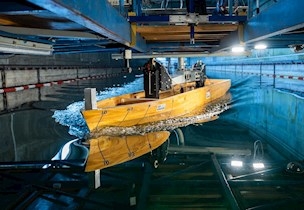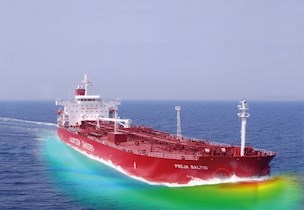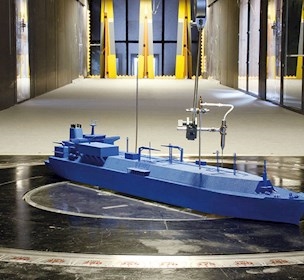Dynamic positioning investigations
With a reliable DP system, you will be able to operate at sea without mooring or anchoring; operations which otherwise would have been impossible.
Our DP investigations are a range of tasks which can be performed individually or as a complete package. The tasks are:
- numerical evaluation of DP capability utilising our DPLab – holding capability module
- thruster-hull & thruster-thruster investigations performed in our Planar Motion Mechanism (PMM)
- full DP model tests where the model is controlled by either our in-house controller system or by a specific DP vendor system.
Dynamic positioning tests in the towing tank
The dynamic positioning tests are performed in our deep water towing tank which is fitted with a very powerful wave maker. The powerful wave maker makes it possible to investigate adverse slamming incidents on fixed and floating structures. Tests can include both wind and current.
Motions are captured in 6 degrees of freedom by our advanced and accurate optical tracking system. This data is used to feed the DP system which also includes a wind feed forward system, if relevant.
The models will be fitted with relevant transducers and equipment such as wave probes, pressure transducers, load sensors, accelerometers etc.
DP Lab
We have developed the Holding Capability Module for the DPLab software for in-house use or as software sold in a package with wind and current predictions or wind tunnel model tests. The program follows the recommendations of IMCA M 140.
The tool performs static calculations, balancing the available thrust and the environmental forces. The holding capability is defined as the limiting environmental forces (arising from wind, current and waves) that can be balanced by the vessel using its propulsive systems in an optimal way.
Using DP Lab
Once the key data for the vessel or platform has been assembled and entered into the program, various analyses can be performed. The program allows the user to easily change the type, size and position of the thrusters.
One of the key aspects for any operator of a vessel with DP capability is to evaluate the ability to stay at position in case of failure of one or more units. This task can easily be carried out by DPLab, thereby providing the client with a rapid evaluation of the failures and their effects on DP capability.
The required basic input to DPLab is:
- vessel geometry
- wind and current forces coefficients
- 2nd order wave drift forces
- thruster types, sizes and positions
- thruster efficiency (thruster-thruster interaction and thruster-hull interaction).





